
The Irish Free State was created by the Anglo-Irish Treaty signed in London on 6 December 1921, following the bloody Easter Rising of 24 April 1916 and the ensuing Irish War of Independence (21 January 1919 to 11 July 1921). The Treaty was intended to come into effect on 6 December 1922, but following its ratification by the Irish Parliament on 7 January 1922, opponents of the Treaty (the Republicans) rose in revolt, and were opposed by the Irish National Army (INA). The latter inherited armoured cars from the British (Rolls-Royces, Peerless and Lancias), and began constructing armoured trains and trolleys to counter Republican attacks on the railways. In addition, the Railway Protection, Repair and Maintenance Corps (RPR&MC) was created in October 1922.
The first armoured train was based at Inchicore (Dublin) in July 1922, but it was destroyed by the Republicans. In August a second train was constructed in Limerick, using armour plates found in an abandoned British barracks, and other trains of variable effectiveness existed in Clonmel, Dundalk and Thurles. Following the creation of the RPR&MC, armoured trains were built in Cork and Dublin. The armoured train detachments organised by the RPR&MC and set up in Clonmel, Cork, Killarney, Limerick and Thurles had a total of nine trains, and in February 1923 they were stationed as follows: Clonmel: AT No 1; Thurles: AT No 2; Limerick: AT No 3; Cork: AT Nos 4, 5 and 6; Dublin: AT No 7; Dundalk: AT No 8; Mullingar: AT No 9.
The trains’ main role was the protection of working parties repairing destroyed bridges and damaged track. In between the fixed bases, regular patrols were carried out by armoured trolleys. Of the various makes of Irish armoured cars, only the Lancia1 armoured personnel carriers were converted for use on rails. Out of a dozen set aside for conversion, only seven (AL Nos 22, 23, 31, 32, 33, 47 and 51) were in fact fitted in September 1922 with flanged wheels. Their configurations varied between individual cars, and at least two of those converted at Inchicore were fitted with a turret armed with a machine gun.
The Republicans in general preferred to avoid combat with the trains and trolleys, leading to less attacks on the railway which nevertheless continued to suffer. The fighting which did take place was often hotly contested. For example, on 15 October 1922, it took the Republicans some four hours of fighting to force the surrender of the famous Lancia known as the Grey Ghost (from its camouflage scheme and its near-silent approach). After being disarmed, the crew were set free, and the Lancia partly destroyed by fire. On 27 February 1923 the Lancia trolleys were based as follows: Cork: Lancias Nos 1, 2 and 3; Limerick: No 4; Dundalk: No 5; Dublin: Nos 6 and 7. In addition, a further five Lancias had been set aside for quick conversion to trolleys. At the end of the Civil War, the Lancia trolleys were restored to road use and passed to the Armoured Car Corps.2
In 1931, the Irish Government expressed interest in the project by the Swedish firm of Landsverk, described in the chapter on Sweden, but no orders resulted.
The Army High Command envisaged the construction of an armoured train in 1941, to be built around a diesel locomotive. However, the GSR turned down the idea, because of the impossibility of obtaining armour plate, and the lack of a sufficiently powerful locomotive to carry armour in the first place.

Armoured train built by the Great Southern Railway, and crewed by its employees under military supervision.
(Photo: Irish Military Archives)
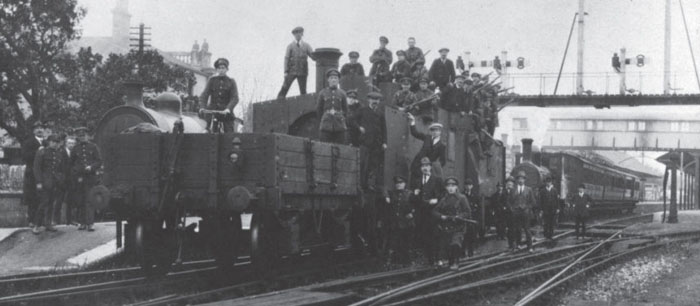
Armoured train photographed at Mallow in 1923. The engine is a 4-4-2 tank of the GSWR.3
(Photo: Walter McGrath Collection)
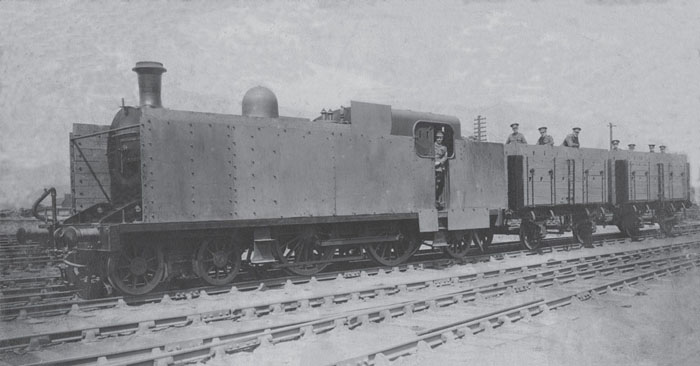
Armoured train photographed on 14 February 1922. The internal wooden supports holding the armour plates are clearly visible at the front of the engine. With internal Stephenson valve gear, these tank engines carried no protection below the footplate.
(Photo: Paul Malmassari Collection)
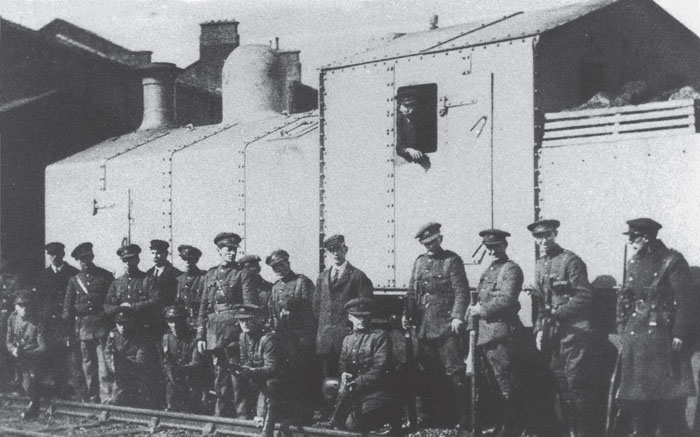
A view of the armoured train of the DSER,4 here in Grand Canal Street, Dublin in 1923.The engine is 2-4-2 No 64 Earl of Bessborough.
(Photo: All Rights Reserved)
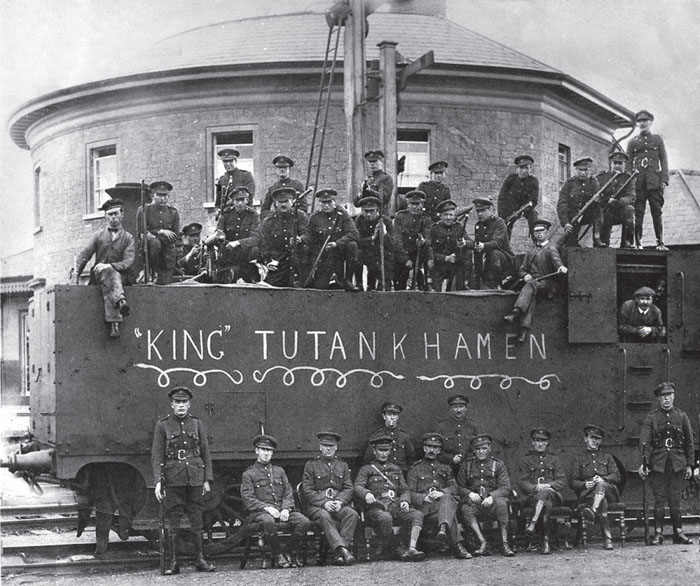
Amusing play on words on ‘the tank’ engine of Armoured Train No 7. The discovery of the Pharaoh’s tomb by Carter had taken place in 1923 and the news was all the rage at the time.
(Photo: Irish Railway Record Society)
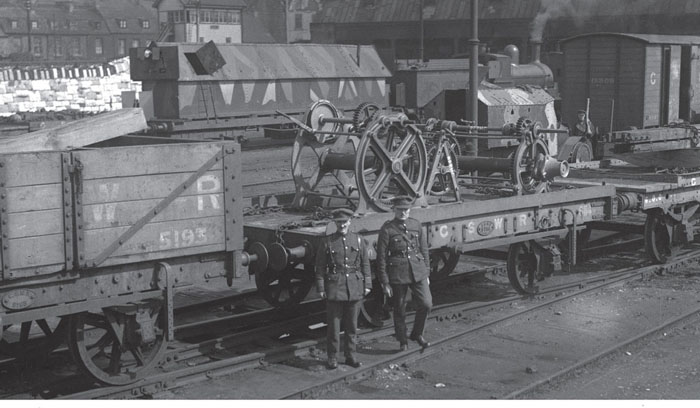
Behind the repair train we can make out the armoured train from Cork, and behind the horizontal capstan is the famous Lancia, the Grey Ghost.
(Photo: Irish Military Archives)
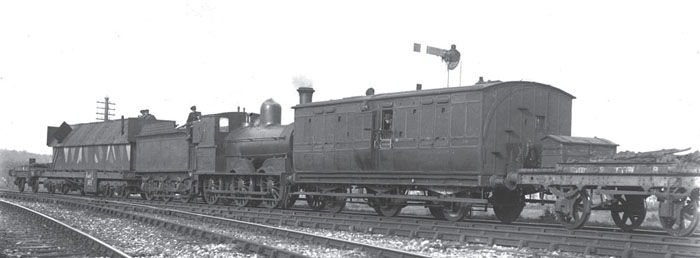
The complete armoured train from Cork, powered by a Class 101 GSWR 0-6-0 engine. The imposing armoured wagon at the rear had been built by the workshops of the CB&SC.5 Note the carriage in front of the engine, armoured with plates over the windows, pierced by loopholes. On the other hand the engine crew are protected only by a simple plate at each side.
(Photo: Irish Military Archives)
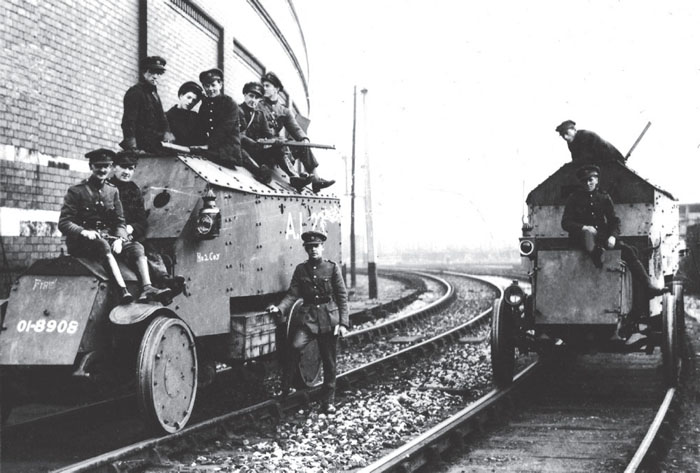
Two Lancia armoured trolleys at Glanmire Road Station, Cork, in November 1922. The machine on the left is of the ‘Hooded Terror’ type, so-called from the nickname of the Lancia which had served as the prototype: the former open-topped crew compartment was now covered by an armoured roof. ‘AL-23’ on the rear of the body indicates ‘Armoured Lancia’ plus its original armoured car designation. It may in fact be Lancia Trolley No 1, and is ascribed to No 2 Company as marked on the left-hand cab door.
(Photo: Walter McGrath Collection)
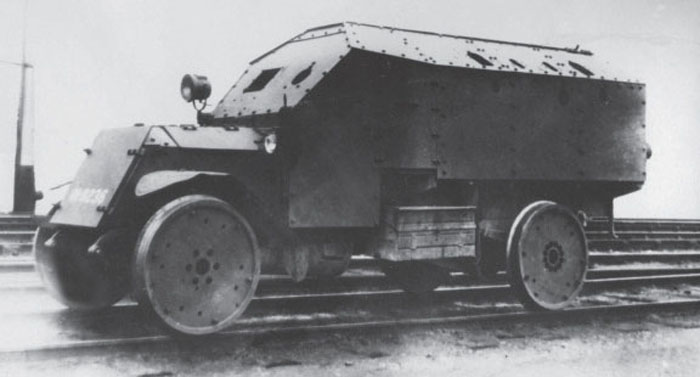
A variant of the Lancia armoured trolley, photographed at Inchicore, with armour similar to that of the Grey Ghost.
(Photo: Irish Military Archives)
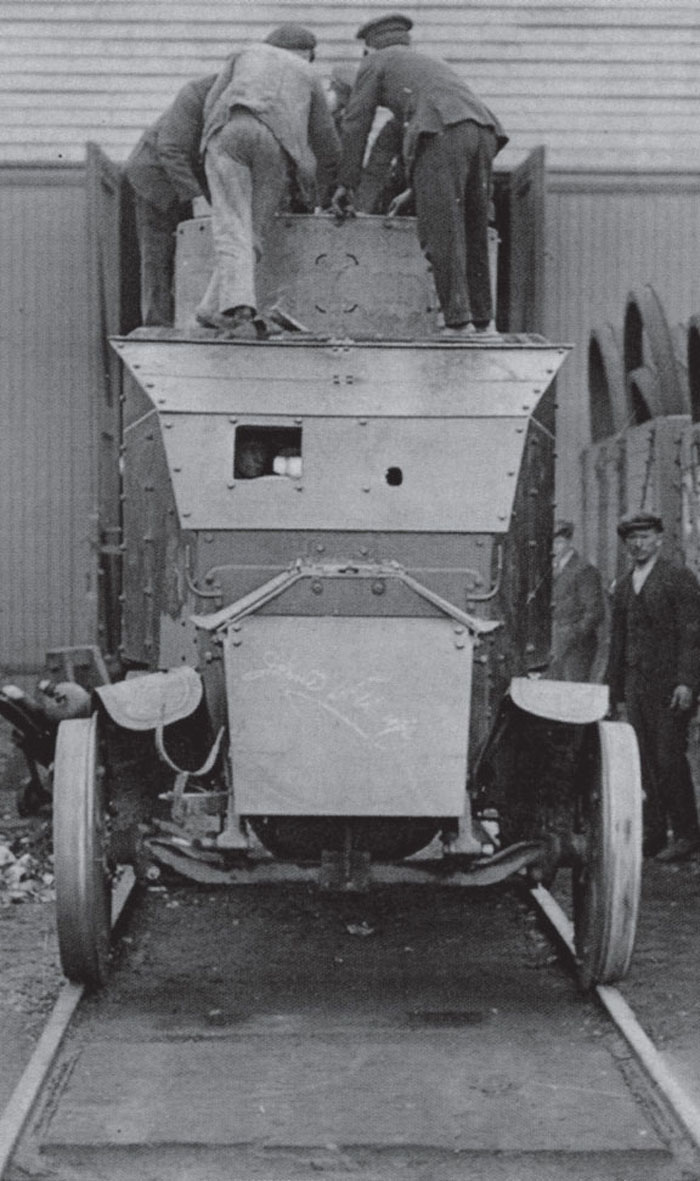
The second Lancia trolley fitted with a turret, seen in the Inchicore workshops. The generous Irish track gauge of 5ft 3in (1600mm) is particularly noticeable here: the mudguards are no longer aligned with the road wheels. To fit the latter required an extension to each axle.
(Photo: All Rights Reserved)
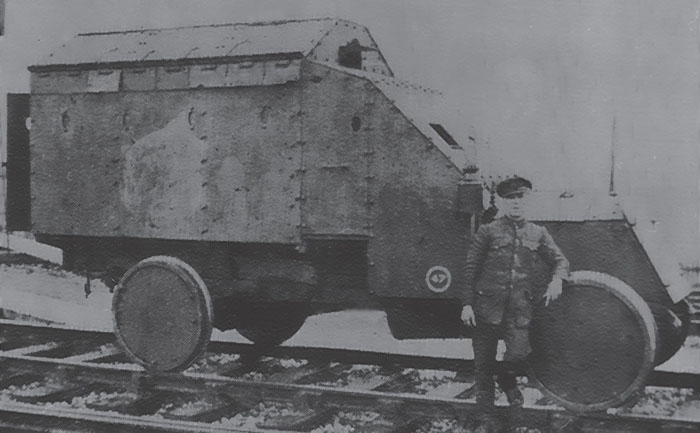
Yet another variant, with a different type of roof armour.
(Photo: All Rights Reserved)
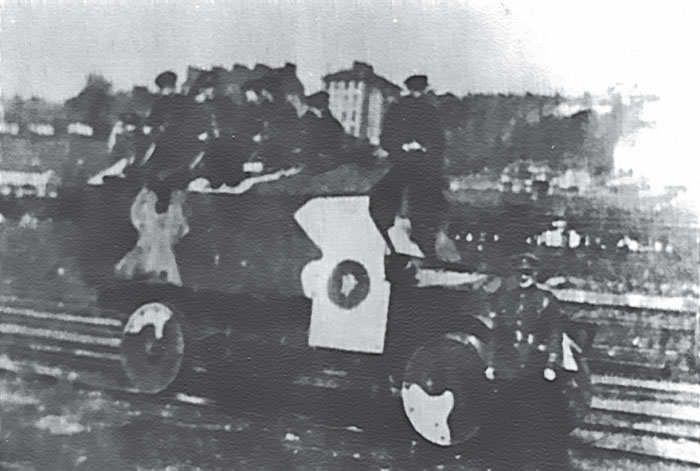
The Grey Ghost, the famous Lancia which resisted a Republican attack for some four hours, before the crew surrendered, and the trolley was set on fire.
(Photo: Irish Military Archives)
SOURCES:
Archives:
Irish Army Ref 2/69329.
Books:
Share, Bernard, In Time of Civil War, The Conflict on the Irish Railways 1922-23 (Cork: The Collins Press, 2006).
Conference Notes:
Walsh, Paul V, The Role of Armoured Fighting Vehicles in the Irish Civil War, 1922-1923. Lecture presented in September 1997 at the Cathal Brugha Barracks.
___________, The Irish Civil War, 1922-1923: A Military Study of the Conventional Phase, 28th June-11th August 1922. Lecture presented 10 February 2001 during the 6th Annual Conference of the Barnes Club of Temple University.
Journal articles:
Bergin, Lieutenant-Colonel W J, ‘Ambush on the Grey Ghost’, An Consantoir (May 1978), pp 135–6.
Leslie, Peter, ‘Armoured Rail Cars in Ireland’, Military Modelling Annual (1974), pp 6–9.
McCarthy, Denis J, and Leslie, Peter, ‘Armoured Fighting Vehicles of the Army No 3; The Lancia Armoured Personnel Carrier’, An Consantoir (May 1976), pp 136–8.
Website:
http://railwayprotectionrepairandmainten.blogspot.fr/
1. The Lancia armoured personnel carriers were originally British vehicles built on either Lancia 1 Z or Lancia Triota chassis, 100 examples of which were in service with the Irish National Army. Crew: eight or nine men; speed: 45mph (72km/h) forward, 20mph (32km/h) in reverse; armour: 6mm; armament: .303in Lewis LMG.
2. On the other hand, Peter Leslie states that several Lancia trolleys and an armoured train dating from the Civil War period were stored in a siding up until the 1950s.
3. GSWR = Great Southern & Western Railway.
4. DSER = Dublin & South Eastern Railway.
5. CB&SC = Cork, Bandon & South Coast Railway.